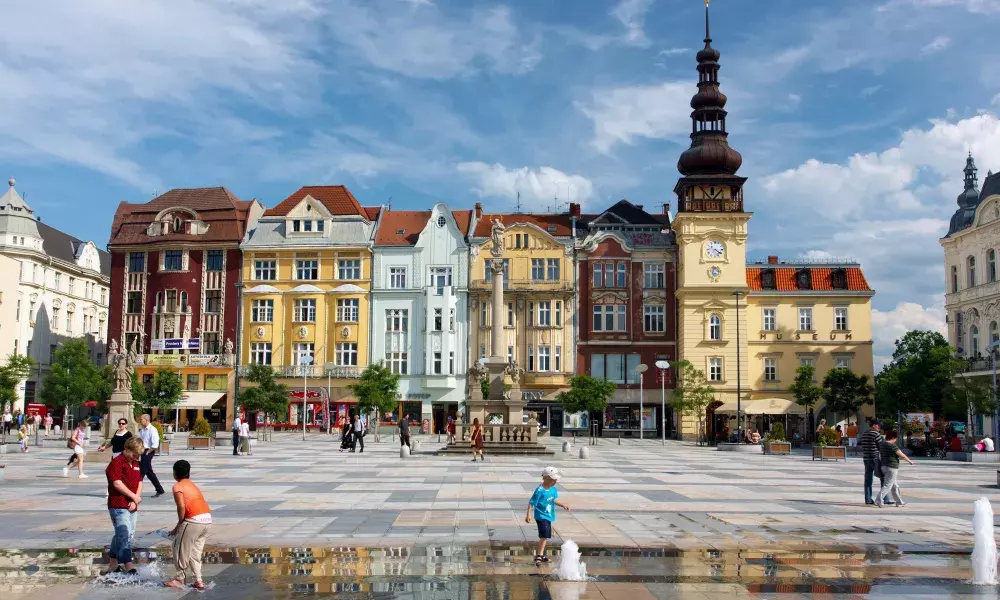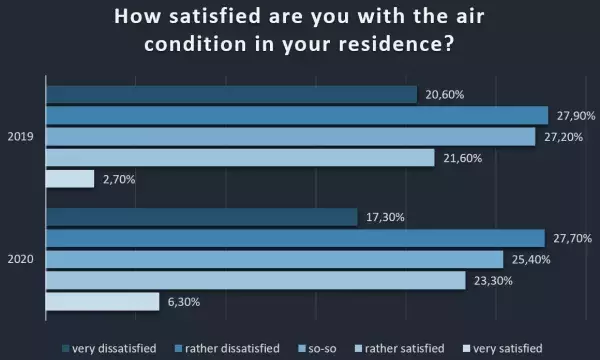CLAIRO public opinion surveys: Results reveal concerns about air quality and openness towards urban greening in Ostrava agglomeration

In Ostrava and nearby towns two public opinion surveys were conducted under CLAIRO on air quality in 2019 and 2020 by the Regional Association of Territorial Cooperation of Teschen Silesia (RATCTS) and SOBIC, a research and innovation institute.
The surveys were undertaken to support the replication of the approach promoted by CLAIRO, the transfer of a solution aiming at the reduction of air pollution with the help of greenery across the Moravian-Silesian Region. Additionally, the surveys functioned also as outreach campaigns supporting awareness raising on clean air among residents of the Ostrava agglomeration. During the interviews, respondents obtained basic information about the sources of air pollution in their area, examples and uses of different types of urban vegetation, the role of composition of greenery in improving air quality and about the activities of the CLAIRO project.
Both in 2019 and 2020 the surveys were undertaken in the October-November period, and in both cases slightly over 600 respondents were interviewed. The same questions were asked in both surveys. The autumn period was carefully picked for the interviews. During this time of the year air quality is already worsening in the region and as such it becomes a more relevant issue for respondents. Additionally, in October and November because of the relatively good weather it is easier to address people in the streets. The coldest months were avoided, as in wintertime due to poor air quality residents can become biased about the topic.
Apart from Ostrava, respondents were from towns and smaller municipalities of the Moravian-Silesian Region: Bohumín, Ceský Tesín, Frýdek-Místek, Havírov, Karviná, Opava, and Trinec. Almost half of the respondents were from Ostrava. The results of the two surveys will be analysed in detail by SOBIC and RATCTS in a study to be prepared by Autumn 2021.
A focus on air quality, greenery and behaviour of residents
Of course, Covid-19 had an impact on the execution of the survey in 2020. As the second wave of the pandemic has hit the Czech Republic in autumn, restrictions were enacted across the country. The team responsible for the survey was lucky enough to start with more intensive data collection early on, already in the beginning of October. In this period local residents were still willing to participate in the survey in a larger number. By the time people became more wary to stop in the streets and speak with strangers because of the rising case numbers, the majority of the 600 interviews were already done. With the early start the team managed to reach altogether 600 people similarly to the previous year.
Gabriela Kaluzova, International Project Manager and Consultant at SOBIC highlighted the benefits of the public opinion surveys:
A part of the surveys related to the perception of air quality topic had been already researched in the past and will enable to follow the evolution in longer time perspective. On the other hand, another section of the surveys on urban greenery in relation to air quality has not been realized before and will provide regional municipalities with an interesting message from their citizens. Moreover, the research enables tracing the willingness of regional citizens to adapt or change their behaviour in favour of clear air. Finally, the in-depth surveys, involving 1207 respondents in total, enabled to address citizens from the whole agglomeration with basic information on the project outputs and thus contributed to awareness-raising on the positive impacts of urban greenery.
The interview questions were clustered under three distinct themes, air quality, urban greenery and the willingness of people to change their behaviour to improve air quality.
The pandemic sheds light on the relevance of clean air
Are inhabitants of the Moravian-Silesian Region interested in air quality related issues? Is the topic relevant for them? How do people rate air quality in their neighbourhoods? Do they think that air quality is better today than it was 10 years ago? A part of the survey searched answers to these questions.
The results showed that almost 60% of the people living in the Ostrava agglomeration take an active interest in air quality and also consider topic to be very important. Apparently, the pandemic highlighted the importance of air quality, as slightly more people considered the issue relevant in 2020 than in 2019. Unsurprisingly, respondents with higher level of education showed a more serious interest in the subject, and a higher proportion of them believed that the topic is very relevant.

share of residents taking an active interest in air quality and considering the topic to be very important in 2020
On the other hand, the survey indicated that almost 50% of the population of the Ostrava agglomeration is dissatisfied with local air quality. The fact that a large proportion of the inhabitants perceive the air quality to be poor implies that people are not only interested but also concerned about the subject. However, the share of respondents that are satisfied with the quality of the air more than doubled in 2020 as compared to 2019 from 2.7% to 6.3%. This change might be explained by positive articles related to coronavirus lockdown with less traffic and restricted industry that resulted in clear skies globally.
On the other hand, the survey indicated that almost 50% of the population of the Ostrava agglomeration is dissatisfied with local air quality. The fact that a large proportion of the inhabitants perceive the air quality to be poor implies that people are not only interested but also concerned about the subject. However, the share of respondents that are satisfied with the quality of the air more than doubled in 2020 as compared to 2019 from 2.7% to 6.3%. This change might be explained by positive articles related to coronavirus lockdown with less traffic and restricted industry that resulted in clear skies globally.

share of residents dissatisfied with local air quality in 2020
There is evidence that the quality of the air in Ostrava has been significantly improving for a longer time. Measurement of the concentration of air pollutants indicated that in a five-year period the air was the cleanest in 2019, already before the coronavirus pandemic. This improvement is due to the restructuring of the industry, a unique road cleaning program that aims at the reduction of secondary dust, and a package of other air quality related measures adopted by the City of Ostrava.
Still, survey results highlighted that more than two thirds of respondents are convinced that the current state of the air is either the same or worse than it was 10 years ago. The reason for this can be that much more information is available now about air quality than it was a decade ago, the topic having a better coverage in the media. It is still unclear that the reason for this general perception can be explained by a lack of awareness of the changes related to air quality, or by an increasing sensitivity of the people to the topic.
New forms of greenery are welcome
The part of the survey focusing on urban greenery addressed the following questions: Would you welcome new forms of greenery in urban areas, such as vertical gardens, green façades or roofs? Do you think that the composition and structure of planted greenery can affect the air quality? These questions were meant to inform on various solutions as well as to test whether the approach promoted by CLAIRO is supported by the public. Before these questions were addressed, pictures were shown to respondents about various types of nature-based solutions.

Answers were overwhelmingly positive. Three-quarters of the respondents would support the development of new forms of greenery in urban areas, such as green roofs and green façade walls. Over 80% of the respondents receiving the information believe that the structure of greenery in urban areas can influence air quality. There were great differences though between typical responses depending on the level of education. Support for using these new forms of nature-based solutions was shown to be rising sharply with higher level of education.
Many are willing to actively help
Finally, the surveys also tried to assess respondents’ preparedness for changing their attitudes and lifestyle in support of a better air quality. Would they be willing to actively contribute to the improvement of air quality in their neighbourhoods? How would they do that? Through modernizing their boilers? Using sustainable modes of transport? Supporting the planting of greenery? Would they be also willing to financially contribute to a better air quality?
Nearly 60% of respondents stated their willingness to contribute in general to the improvement of the air in their neighbourhood. People in the region is less willing to make changes in the way they live than in the way they move around. Almost 70% of the respondents do not plan to switch to a more sustainable heating system. Altogether 74% of the respondents reported to use sustainable modes of transport, such as public transport, cycling and carpooling, and 43% use these regularly. Most importantly from the perspective of CLAIRO, 90% of respondents were found to support greenery planting. Results show that around 45% of the respondents are willing to provide to the municipality financial support for planting greenery or adopting other measures that target the improvement of air quality.
A focus on clean air can catalyse action
Gabriela Kaluzova pointed out that
the positive attitude towards urban greenery and behavioural change was expected, nevertheless, on smaller scale.
She has found the lack of satisfaction with air quality in the region to be rather worrying despite the significant improvement in the last decades. On the other hand, she has highlighted that the fact that more than 40 % of respondents would be happy to support financially urban greenery planting is an important and strong signal for decision-makers.
It is also a particularly relevant message for local policy-makers of the Ostrava agglomeration that the topic of air quality is very important for almost 60% of the respondents. The survey results also confirm that people living in towns nearby Ostrava are open for the adoption of the approach of CLAIRO that target at reducing air pollution with the help of urban greenery, clearly highlighting the relevance of clean air and nature for decision makers.
About this resource
The Urban Innovative Actions (UIA) is a European Union initiative that provided funding to urban areas across Europe to test new and unproven solutions to urban challenges. The initiative had a total ERDF budget of €372 million for 2014-2020.
Similar content




